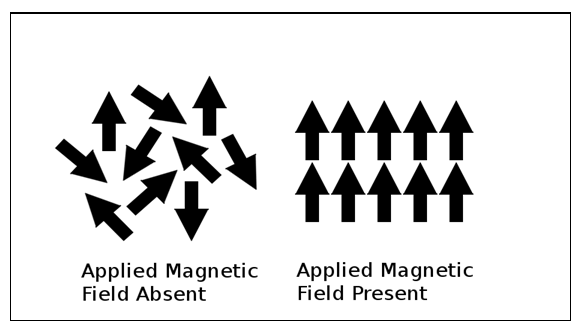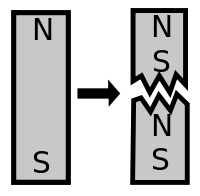The other basic property of quantum matter, along with mass and charge, is quantum spin. We know that dividing a magnet gives two small magnets and joining two small magnets gives a big one. If big magnets come from smaller ones, all magnetism must trace back to the smallest possible magnet, which in physics is an electron.

Metals become magnetic when their electron magnets align the same way. If electrons align randomly the net effect is zero but if they align the same way, the metal becomes magnetic (Figure 5.11). In contrast, the electrons in plastics aren’t free to align so they can’t be magnets. Magnetism occurs when electrons align.
An electron is essentially a tiny magnet whose north pole is at right angles to its spin and its south pole is the opposite way. Spin is an inherent property of quantum matter, like mass and charge, so all quantum entities spin. In current physics, spin is imaginary because an electron as a point particle can’t spin but in quantum realism, an electron has a structure that spins in quantum space. Either way, quantum spin relates directly to magnetism and matter becomes magnetic when its electrons align their spin in the same direction.

A positive-negative body splits into positive and negative parts but instead of splitting into north and south parts, a magnet splits into two more magnets, each with a north and south pole (Figure 5.12). An electron, the tiniest magnet, also has a north and south pole even though it is a point particle that can’t split into parts.
A spinning electron has north and south directions not parts. If quantum spin creates a magnet, then north and south poles are directions related to spin, suggesting that a north pole can’t exist without a south pole, just as a plate with an up direction always has a corresponding down direction.
If spin causes magnetic poles, a single pole can’t exist but the standard model touts a magnetic monopole, an elementary particle of one magnetic pole. No evidence exists for magnetic monopoles but they are another fruitless standard model search like WIMPS, squarks and gravitons.
In this model, an electron as one-dimensional matter rotates about its matter axis. Recall that an electron must do two 360° turns to spin once. If electron spin was in physical space, a matter axis rotation wouldn’t alter it but as noted earlier, quantum space allows three additional orthogonal directions to give two more rotation planes through any axis. As electron spin occurs in all possible directions, it also spins in these planes so an electron needs two turns to spin entirely.
The Pauli exclusion principle lets opposite-spin electrons exist at the same point but not same-spin electrons. It describes an observed fact but quantum realism explains why. If two electrons at the same point spin in opposite ways, the first turn takes them into different parts of quantum space and the second turn does the same, so if one electron spins “up” and another “down” at the same point, they never overlap. In contrast same-spin electrons at the same point compete for the same quantum space that only one can fill. Quantum space explains why opposite spin electrons can exist at the same point but same spin electrons can’t.
In this model, the quantum processing of matter spreads spin on the quantum network, as well as mass and charge, so it creates a spin gradient around itself. If same magnets spread the same spin and opposite magnets spread the opposite spin, by the Pauli principle, same magnets interact to concentrate the quantum field while opposite magnets interact to dilute it.
Like charge, one magnet alone has little effect on neutral matter but for two magnets the spins interact to alter the quantum field between them. For opposite magnets, it dilutes as opposite spin electrons don’t overlap while between same magnets, it concentrates as they use the same quantum space. The expected effect is to slow down the quantum network between opposite magnets and speed it up between same magnets, and this causes movement as for charge.
A magnet alone doesn’t move because the quantum field around it is the same in all directions. But add a same magnet nearby and their spin gradients interact to slow down the quantum field between them so same magnets repel because they restart less often towards each other. In contrast, an opposite magnet nearby speeds up the quantum field between them so they attract because they restart more often towards each other. It follows that same magnets repel and opposite magnets attract due to an interaction between their spin gradients that we call magnetism.
Electric and magnetic fields then relate because both are based on electrons.If electricity is electrons moving as matter, their matter axes must align in the movement direction for it to happen. If electrons align their matter axes to move as electricity, they also align spins to give magnetism at right angles, as the spin plane directions are at right angles to the matter axis. Electrons moving one-way spin one-way but moving the other way spin the other way. A current creates a magnetic field because electrons align spins when they move. Equally, when a magnet moves, the magnetic field changes at right angles to a line from the magnet making electrons move that way as a current.
Attributing magnetism to the spread of quantum spin also suggests why magnetism disperses faster than charge, as while charge spreads in two dimensions by Gauss’s law, magnetism spreads in a more complex way into three dimensions.
In quantum realism, charge remainders interact to speed up or slow down the share cycle of the network between them and magnet spin directions interact to speed up or slow down the execute cycle. In both cases, the effect is to bias the quantum field to cause matter to move.